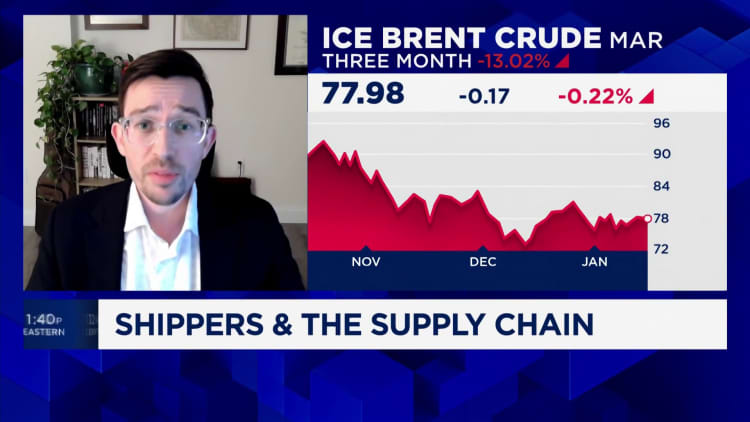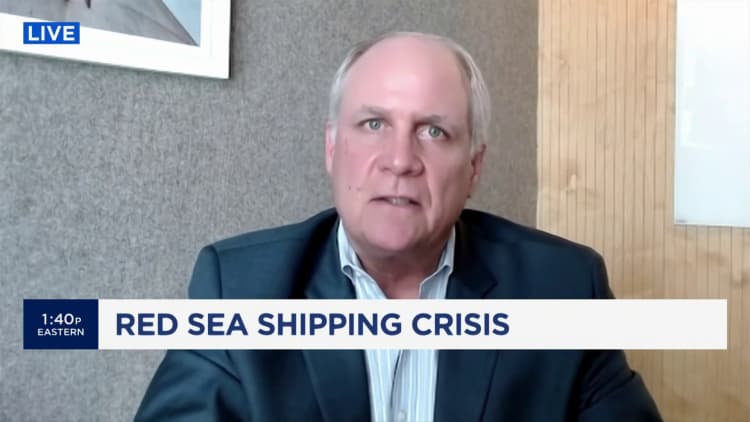A screen grab captured from a video shows that cargo ship ‘Galaxy Leader’, co-owned by an Israeli company, being hijacked by Iran-backed Houthis from Yemen in the Red Sea on November 20, 2023. (Photo by Houthis Media Center / Handout /Anadolu via Getty Images)
Anadolu | Anadolu | Getty Images
The ripple effects of the Red Sea diversions have expanded into the energy markets and despite repeated attacks on Houthi rebels by the U.S. and allies, shipping experts say the crisis may linger for months and lead to a cargo container supply crunch.
“So far, it almost seems the Houthi attacks are just increasing,” said Bendik Folden Nyttingnes, a shipping analyst at Clarksons Securities.
In an email to clients, Honour Lane Shipping (HLS) said its carrier contacts are “informally” predicting the Red Sea situation will not be solved for at least six months, and could last up to a year. “If so, we expect the soaring freight rates and equipment shortage will continue till the third quarter,” it advised clients.
Earlier this week, Shell confirmed that its oil tankers are temporarily being rerouted around the Red Sea, with its CEO telling the Wall Street Journal that a 5-10% price impact is anticipated in the short-term.
Kpler’s ship tracking director Jean-Charles Gordon estimates that vessels managed or chartered by Shell that are being rerouted via the Cape of Good Hope can expect an approximate 10-day delay in their estimated time of arrival.
“As several product tanker operators are avoiding the area following the airstrikes on Friday, the longer transit times around the Horn of Africa could create a supply shortage of tonnage if the situation continues, which in line could push product tanker rates and stocks higher,” Nyttingnes said.
Torm , Hafnia, Stena Bulk, Hafnia, BP, Frontline, Equinor, Euronav are reportedly among the tanker operators and energy companies choosing to avoid the area following recent warnings. Companies including Tom, Hafnia, Scorpio Tankers and Ardmore would benefit if product tanker rates rose, Nyttingnes said.

These diversions are immediately eating into Egypt’s economy, with its GDP reliant on the Suez Canal, which it owns and operates. The country’s other significant source of revenue, travel, has been decimated because of the Israel-Hamas War.
“If Total Suez Canal tanker transits are over 8 million barrels per day, the losses to the Canal Authority are probably in the range of $5 to $7 million depending on the mix of tankers going through,” said Andy Lipow, president of Lipow Oil Associates.
This would be on top of the revenue lost by diverted container vessels which are required to pay between $500,000-$600,000 per transit. According to Kuehn + Nagel, 90% of container ship traffic bound for the Suez Canal has been rerouted.
50% of all Suez traffic could be rerouted
A drop of 40-50% in all vessel Suez crossings as a result of shipping diversions is possible, according to Ami Daniel, co-founder & CEO of Windward, which could create a situation similar to the Covid supply chain crunch for many retailers reliant on global supply chains.
Logistics CEOs have been warning CNBC the vessel re-routings would result in container crunches. When vessels are late, the containers on those vessels will be late to be processed and reused again for exports.
Goetz Alebrand, head of ocean freight Americas for DHL Global Forwarding, has been warning about an upcoming container crunch for weeks. “More than 4 million containers (Twenty-Foot Equivalent Units) are bound for longer transit times and will not be ready in the Asia Pacific for the next loading,” he warned. “Considering a two-week delay in either direction it could mean that four million times of containers will be needed to have availability.”
The Asia to Europe route is the most impacted by delays. The ripple effect of this bleeds into the ability of European exports to move out at a fluid rate.
“Europe has felt the most impact from the situation in the Red Sea given it is the major trade route for goods coming from Asia,” said Stephen Schwarz, executive vice president of Wells Fargo global receivables & trade finance. “However, with more ships being diverted and taking alternative, longer routes to Europe, it is starting to impact global capacity. The delay of containers, reduced capacity, and longer transit times all influence global shipping costs which will start to impact U.S. companies the longer the situation in the Red Sea continues.”
Paolo Montrone, global head of trade for Kuehn + Nagel tells CNBC the container crunch situation currently unfolding will have a knock-on effect on European exports.
“We anticipate encountering challenges in European terminals as larger ships are expected to arrive outside of their scheduled times. This influx is likely to cause congestion and slowdowns at terminals and ports, subsequently affecting other services such as shipments from Europe to the USA.”
Companies with higher-value items and time-sensitive products are also shifting to the air. “Drawing from past experiences, we foresee an increase in the need for air freight services in the upcoming weeks,” said Montrone.
Alan Baer, CEO of OL USA said he is expecting the container crunch to impact Asia as well.
“Recently carriers reduced the amount of free time on import containers to help expedite the return of equipment back to Asia,” said Baer. “However, given the longer transit times vessels are experiencing, the market may face a shortage of empties across Asia until sailings normalize.”
U.S. retailers say they are prepared
The delays of vessels during the pandemic had some retailers like Home Depot, Costco, and Walmart hiring charters to speed up deliveries.
Evelyn Fornes, Home Depot spokeswoman, said it is working with logistics carriers to find alternate routes to limit any impact from the Red Sea conflict.
“As a regular course of business, we always have plans in place for potential disruptions to any of our partners,” Fornes stated via email. “We have a large and diverse supply chain with a number of partners, so we’re accustomed to being flexible and agile when there are disruptions. This type of flexibility is what allowed us to adapt and move the unprecedented volumes during the pandemic, despite significant disruptions.”

“Target remains confident in our ability to get guests the products they want and need,” a Target spokesman said via email. “We leverage production and transportation partners across the globe, and the majority of our freight does not travel through the Suez Canal. For any freight that’s being routed around the Suez Canal, we’re working with shipping partners on alternative paths.”
While retailers are expressing confidence, Tesla, Volvo, and Michelin have recently said they have had to halt manufacturing. Ikea has warned of delays of product, as well as British retailer Next and Crocs.
Costco and Walmart did not respond to requests for comment.
East Coast freight rates soar
While freight rates for U.S. West Coast ports have yet to spike, freight rates for the East Coast and Gulf are up. U.S. East Coast rates are between $5,900-$6,700 for a forty-foot container, and rates for the Gulf are between $6,300-$6,900 a 40-foot container, according to Honour Lane.
To avoid delays and fees, some logistics companies are re-routing to the U.S. West Coast, which could result in higher rates eventually.
“U.S. West Coast space is also getting tight as a substantial number of boxes destined for U.S. East Coast /Gulf destinations are being re-routed through US West Coast hubs,” wrote HLS. “Some big Beneficial Cargo Owners like Walmart have proposed to increase their allocation to the US West Coast and reduce allocation to US East Coast.”
The rates for East Coast and Gulf Coast containers are expected to go up even more. In an advisory to clients Tuesday, MSC alerted of both general rate increases and peak season increases starting February 12 for import containers from the Middle East/Indian Sub-Continent to U.S. East Coast, Gulf Coast and San Juan.
Refrigerated containers called “Reefers” and dry containers, both 20-foot and 40-foot, will be charged a $2,200 peak season charge per container plus a $1,000 general rate increase (GRI) per container. This is on top of whatever container fee the shipper pays.
Some carriers are reportedly planning to deploy more capacity to West Coast for the next contract year, HLS says.
“As the rate difference and transit time difference between US East Coast routings and US West Coast routings are both increasing, the conditions are satisfied for carriers to launch premium services to guarantee space and equipment, which is not strange to us.”
The Port of Los Angeles announced on Tuesday, a total of 747,335 containers were processed in December. This marked the fifth consecutive month of year-over-year growth of the port. Even with its 2023 year handling of 8,634,497 Twenty-Foot Equivalent Units, it was around 13% less than in 2022.

